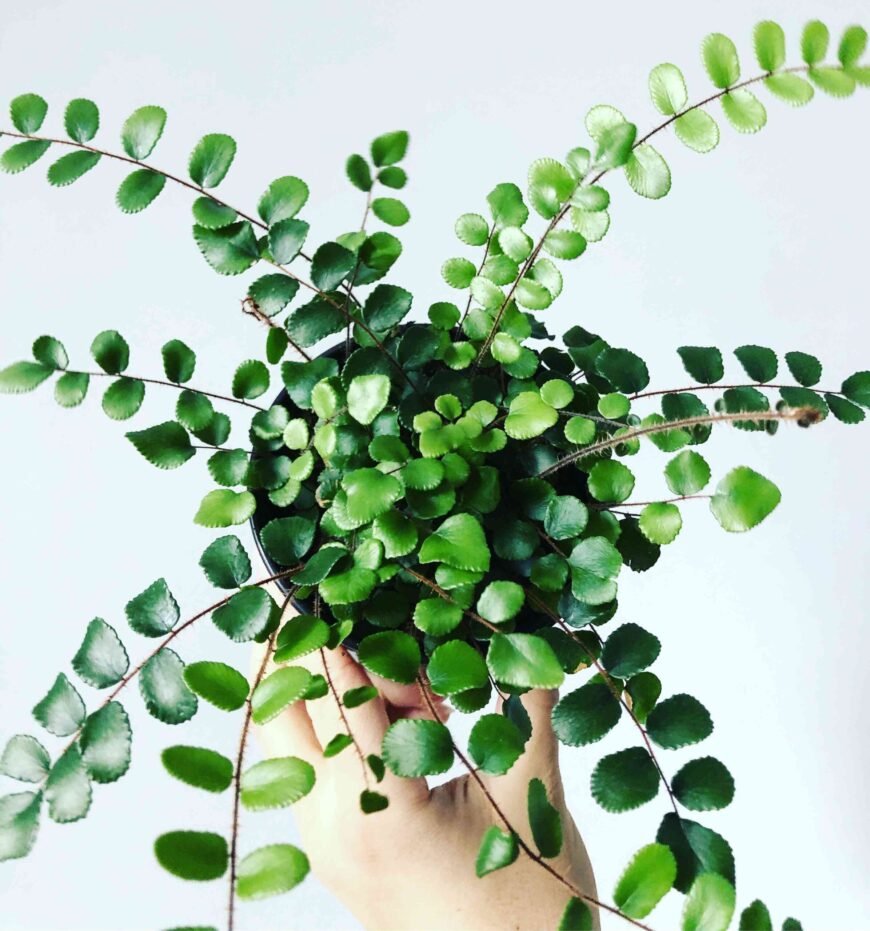| Common Name | Button fern, round-leafed fern, cliff brake |
| Botanical Name | Hemionitis rotundifolia (formerly Pellaea rotundifolia) |
| Family | Pteridaceae |
| Plant Type | Herbaceous, perennial |
| Mature Size | 6-12 in. tall and wide |
| Sun Exposure | Partial |
| Soil Type | Moist, well-drained |
| Soil pH | Acidic |
| Hardiness Zones | 9-11 |
| Native Area | Australia, New Zealand |
Button Fern Care
- Put button fern in a place with medium to bright indirect light.
- Plant this fern in a light, well-drained potting mix that holds moisture.
- Water your button fern when the top of the soil has begun to dry out.
- Feed this plant with a balanced houseplant fertilizer diluted to half strength.
Light
Button ferns require medium to bright indirect light. They can also tolerate lower-light conditions as long as natural light is present, such as from a north-facing window. Keep button ferns out of direct sunlight, which can burn the leaves.
Soil
Plant your button fern in a light, well-drained potting mix. Standard houseplant potting mix typically works well. You can also make your own mix by combining one part peat moss or coconut coir, one part perlite, and one part vermiculite.
Water
Button ferns thrive with moisture, and their soil should never be allowed to dry out completely. Water when the top of the soil is just beginning to look dry.
Make sure your plant drains fully after watering and doesn’t sit in water, which can lead to root rot.
Temperature and Humidity
Button ferns do best in warm conditions with moderate humidity. Give them temperatures between 65°F and 80°F and 40 to 50 percent humidity.
If your plant seems dry and crispy and you’ve been watering regularly, you can run a humidifier nearby to add more moisture to the air around your plant.
Fertilizer
Button ferns don’t need much fertilizer. However, you can give them a balanced liquid houseplant fertilizer diluted to half strength once every two months or so during the growing season.
Start fertilizing when you see new growth in late winter or early spring, then stop fertilizing when days shorten in fall.
Propagating Button Fern
You can propagate button ferns by dividing a mature plant’s rhizomes. It’s best to divide button ferns while repotting them in the spring.
You’ll need gardening gloves (optional), a sharp, serrated knife (optional), fresh potting mix, and small plant pots for as many divisions as you’d like to make. Here’s how to propagate button fern.
- Gently remove the mother plant from its pot. Use your fingers to loosen the soil around the root ball.
- Carefully pull the root ball apart into two halves, making sure each portion has both foliage and rhizomes. If it’s too difficult to separate by hand, you can cut the root ball with a clean, serrated knife.
- From there, you can divide the plant into as many divisions as you’d like, as long as each piece has fronds and rhizomes.
- Fill plant pots halfway with potting mix. Plant a division in each pot, filling in with more potting mix. Water well.
- Keep your divisions in a warm place with medium indirect light. Keep the soil evenly moist but not soggy.
- When you see new growth, you can care for your new plants as usual.
Potting and Repotting Button Fern
Since button ferns aren’t heavy feeders and grow relatively slowly, you can expect to repot them every three years or so. Use fresh soil and only go up one pot size. If you notice roots growing out of the holes in the bottom of the pot or filling the container, that’s a sign to repot sooner.
Common Pests & Plant Diseases
While there are no known pests or plant diseases that seriously affect button fern , they can be susceptible to common houseplant pests like scale, aphids, and spider mites.
Diseases like root rot can affect button ferns that sit in overly wet soil.
Common Problems With Button Fern
Leaves Turning Brown
If your button fern’s fronds turn brown and crispy, that’s likely a sign of underwatering. Check the plant’s soil moisture and water deeply if it’s completely dried out. Monitor soil regularly and water just as the top of the soil has begun to dry out.
Leaves Turning Yellow
Yellowing leaves are a common symptom of overwatering. If your plant has been sitting in wet, soggy soil, let it dry out more than usual before watering again. Only water once the soil surface has begun to dry out.
Browning Tips
Browning tips on your button fern may indicate an overly dry environment. These ferns aren’t as picky about humidity as some are, but very hot, dry conditions may still cause tips to brown. Create a more humid microclimate for your plant by running a humidifier nearby.
-
-
Leaf drop on button ferns is typically caused by stress from severe underwatering. Prevent this by keeping your plant’s soil evenly moist and watering just when the top of the soil has begun to dry out.
-
-
-
Button ferns are pretty easy to grow as houseplants. In fact, they’re more tolerant of indoor humidity and lack of water than some other types of ferns.
-
-
-
Button ferns can grow in partial shade outdoors. Indoors, they prefer medium to bright indirect light but can adapt to lower-light conditions as long as some natural light is available.
-
